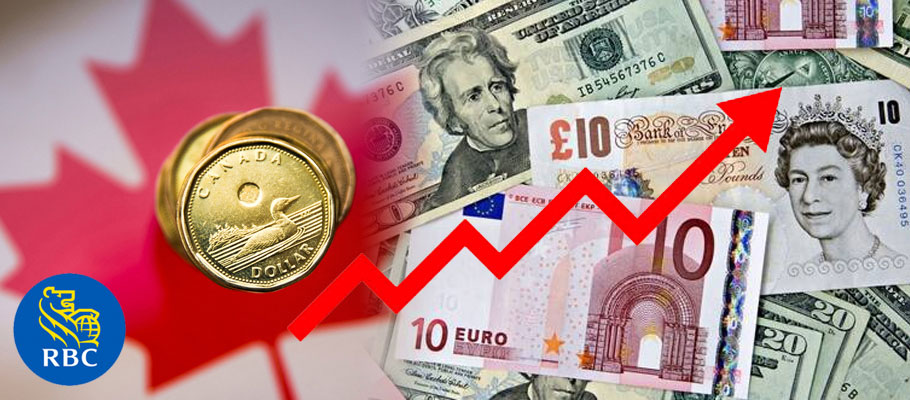
Published: February 21st, 2024
A new research note from Royal Bank of Canada (RBC) predicts the Canadian Dollar will appreciate against Sterling, US Dollar and Euro over most of 2024.
The Loonie has already reached the G10 top three and established itself as one of this year’s best-performing currencies. Because CAD tends to track the Greenback whenever it outperforms, RBC currency analysts have dubbed it the ‘mini-dollar’.
‘The Loonie has been one of the primary outperformers on the crosses this year thanks to its mini-dollar status, with rising Canadian two-year swap rates giving CAD a further lift.’
Expectations for interest rate cuts by the Bank of Canada have receded in recent weeks, resulting in higher short-term Canadian bond yields, the reason why Canadian two-year swap rates have seen one of the sharpest rises in the G10.
But those swap rates aren't simply rising on their own. Canadian swap rates move in parallel with trends in the American economy, one of the reasons why RBC has taken to calling CAD USD’s mini-me.
If the US Dollar continues to outperform, it will be to the benefit of the Loonie over other non-Greenback fiats.
For the year-to-date, CAD is the number three amongst top performing G10 majors after the Dollar and Pound, both of which have benefited from a visible re-pricing of expectations by forex traders for rate cuts still to come from the US Federal Reserve and Bank of England as 2024 plays out.
So far in 2024 the dual impact of stubborn inflation and robustly upbeat economic data has seen rate cut expectations scaled back. The combined effect has left central bank policymakers reticent to commit firmly to interest rate cuts. RBC analysts believe the Bank of Canada will make its first cut in late June, the first instalement of what could total to 100bps of cuts this year.
In January 2024, forex traders reacted to news that Canadian inflation had unexpectedly risen in the final quarter of 2023 and gave the Loonie a lift. Analysts at Toronto bank CIBC said the long-term trend still pointed to a continuing decline, however, that would free the Bank of Canada to cut interest rates before mid-year.
CAD rose against the US Dollar, Euro, and Pound following publication of the inflation print by Statistics Canada. It said November CPI inflation had risen by 3.09 per cent year-on-year, unchanged from October but higher than the consensus reading of 2.9 per cent.
A 0.1 per cent month-on-month increase helped fuel the rise, which was also from the previous month and similarly exceeded the consensus forecast of -0.2 per cent.
The Canadian Dollar was under pressure the previous week after comments from Bank of Canada Governor Tiff Macklem, who told a news conference that interest rate cuts were on the agenda for 2024.
In an analyst note released 15th Janiary 2024, CIBC said the Loonie’s strength could be limited, as the StatsCan figures give little room for central bank policy makers to wiggle out of cut rates in the coming months.
Canada’s inflation drivers are becoming less diffuse and easier to track, CIBC said, and softer trends prevailed in the Bank of Canada's preferred core measures of CPI-trim and CPI-median, 3.4 per cent and 3.3 per cent, respectively. On a 3-month annualised basis, those measures were even softer at 2.3 per cent and 2.5 per cent.
‘While three-month annualised readings can be volatile, if these trends continue for another few months, Bank of Canada policymakers will grow more confident that headline inflation is returning to target. Despite the upside surprise in headline inflation, that paves the way for interest rate cuts from the second quarter of this year.’
A gloomy set of forecasts at mid-year 2023 suggested expectations were growing for a steady decline in the Canadian Dollar's value against the Euro, Pound, and US Dollar.
Despite a bout of outperformance by CAD, investment bank MUFG said the Loonie would experience headwinds as economic worries rose to the forefront.
Analysts at the bank’s Global Markets EMEA unit wrote in a mid-year update that CAD’s recent strength has been mainly driven by the Bank of Canada's (BoC) recent decision to re-start its monetary tightening cycle.
A later economic print, however, suggested there may be weakness in Canada’s labour market alongside a distinct decline in inflation. Both raised trader concerns about how sustainable the Canadian dollar's strength might be.
MUFG pointed to shifting trader expectations about the BoC's monetary policy and the significant role those expectations played in driving the Loonie's appreciation. The two-year US-Canada spread, which tracks the yield differential between the two nations, saw a notable move of nearly 100 basis points from its peak in April to its low in June 2022.
While the USD/CAD pair wasn't sensitive to the shift initially, CAD started to appreciate notably in late May, rising from levels above 1.3602.
The BoC's move to tighten monetary policy was triggered by data that suggested domestic economic resilience.
Other indicators, however, exposed ‘weaknesses in the labour market, with a drop in full-time employment of 32.6 thousand seen in May,’ MUFG analysts wrote. They added that the fight to curb inflation has been successful, lowering the headline Consumer Price Index (CPI) to the BoC's target Median CPI.
MUFG also said that the Loonie’s performance would o be influenced by the ongoing resilience of equity markets.
In March of 2023, data showing resilient Canadian consumer spending had analysts predicting a period of CAD gains.
CAD climbed alongside the Greenback after publication of Statistics Canada data that captured strong retail sales in March, helping underpin growth expectations for North America’s second-largest economy.
Though sales figures were down -1.39 per cent in overall terms for March when big ticket purchases like cars were included in the calculation, sales volume fell by a lesser -0.98 per cent, which suggests widespread discounting by main street shops.